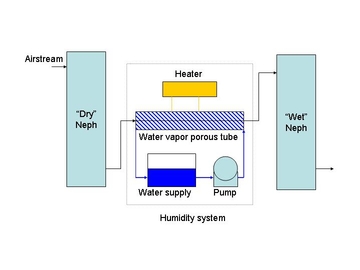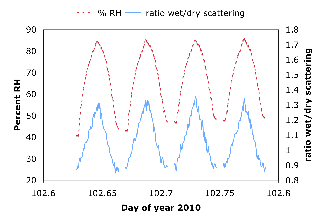Humidity System and Hygroscopic Growth
The aerosol humidifier consists of two concentric tubes. Water circulates between the inner and heated outer tubes. The inner tube is a porous PTFE material that transmits water vapor. The humidifier is used as part of a system to measure the aerosol hygroscopic growth (fRH) or increase in the aerosol scattering coefficient with relative humidity. The humidifier continuously scans the relative humidity from about 30 to 85%. The photo to the left shows the system at SGP. Water circulates from a water reservoir through a small solenoid pump, flow-regulating valve, the humidifier and back through a float valve, filter and into the reservoir.

The humidifier is an annular design consisting of a counterflow water stream around a water vapor permeable membrane. In earlier versions of the humidifier this membrane was stretched on a wire mesh tube. Newer iterations of the humidifier utilize a semi-rigid, shape-maintaining membrane, eliminating the need for the wire mesh. The aerosol air stream flows thru the membrane. The controlled temperature of the water determines the relative humidity to which the air stream is exposed. A detailed description of the most recent version of the humidifier can be downloaded here (pdf file)


This graph shows four hours of humidograph data from SGP. The RH (dashed red line) scans the RH up and down every hour. The blue line shows the ratio of the wet/dry scattering coefficients. The first half hour is sub 10 micron size aerosol and the 2nd half hour is sub micron size aerosol.
Hygroscopic Growth
The humidified nephelometer system allows us to look at the value of light scattering as a function of relative humidity (RH). To be able to compare how this indicator of hygroscopic growth changes for different types of aerosol (e.g., dust, smoke, sea salt, or pollution) we normalize the wet scattering using the scattering at low humidity to derive the dimensionless parameter 'f(RH)'. We define f(RH) as the ratio of light scattering at 85% humidity to the scattering at relative humidities < 40%. (Other research groups use slightly different values relative humidity in their definitions of f(RH). Some examples of how f(RH) changes as a function of humidity, air mass source region and other aerosol optical properties are available for multiple sites (e.g., Titos et al., 2016 and Burgos et al., 2019). It has also been studied for individual NFAN sites: Bondville (unpublished analysis) and Southern Great Plains (from Sheridan et al. (2001)) and Cape Cod (from Titos et al. (2014)). Hygroscopic growth observations have proven useful in evaluating global model simulations of aerosol/water interactions (Burgos et al., 2020).
